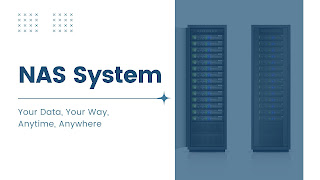NAS System Maintenance: A Step-by-Step Guide for Beginners
Network Attached
Storage (NAS) systems have revolutionized the way we store and share data. With
its ease of use, scalability, and cost-effectiveness, it's no wonder why more
and more people are investing in this technology. However, like any technology,
a NAS system requires regular maintenance to ensure it continues to perform
optimally. In this step-by-step guide, we will discuss how to maintain your NAS
system to keep it operating at its best.
Check and
Update Your Firmware
The first step in
maintaining your NAS system is to regularly check and update the firmware.
Firmware updates often contain bug fixes, security patches, and new features,
which can all help improve the performance and stability of your system. To
check for firmware updates, simply log in to the admin panel of your NAS
system, and check for any available updates. Once you find an update, follow
the system's instructions for installation.
Clean Your NAS
System
As with any
electronic device, dust and debris can accumulate in your NAS system causing it
to overheat and malfunction. This leads to poor performance and a shorter
lifespan of your NAS system. Regularly clean your system by disconnecting it
from power and removing the hard drives. Use a clean, dry cloth to wipe down
the hard drives, chassis, and any other area that accumulates dust and debris.
Check Your Hard
Drives
Your hard drives
are the backbone of your NAS system. Therefore, regular
monitoring is essential to ensure they perform optimally. Use the health
monitoring tools of your NAS system to check for errors and bad sectors. If you
find errors or bad sectors, replace the hard drive as soon as possible to avoid
data loss.
Backup Your
Data
Backing up your
data is an important step in maintaining your NAS system. Data can be lost due
to hardware failure, accidental deletion, or viruses. Therefore, having a
proper backup system in place ensures that your data is safe and accessible
when needed. You can use an external hard drive, cloud-based service, or backup
to another NAS system.
Regularly Check
Your Network
A well-maintained
NAS system can be severely impacted by network issues. Therefore, ensuring that
your network is functioning correctly is essential. Regularly check your
network for any issues, such as slow Internet speeds or disrupted connections.
You can use network monitoring software to track down any issues and promptly
resolve them to avoid further damage.
Change Default
Password
To secure your NAS
system, change its default password immediately after installation. It's also
good practice to use a strong password that includes upper and lower case
letters, numbers, and special characters.
RAID
Configuration
Redundant Array of
Independent Disks (RAID) configuration is another essential component for
maintaining your NAS system. It helps to protect your data against disk
failures by creating multiple copies of your data on different disks. Make sure
to choose the correct RAID configuration according to your storage needs.
Monitor System
Performance
Monitoring your NAS
system's performance is necessary to prevent potential issues. Keeping track of
hard drives' health and temperature, CPU and memory usage, network traffic, and
log messages can help troubleshoot any performance issues effectively.
Check Disk
Integrity
Regularly check the
disk's integrity using disk checking tools provided by your NAS system. It will
help detect disk errors and bad sectors, which can cause data loss if not
addressed promptly.
Disable
unnecessary services
If there are any
services or applications running on your scale
out NAS system that you don't require, it's best to
disable them. It minimizes the system's attack surface and ensures that it's
not running with more resources than necessary, preventing potential
performance issues.
Regular
Shutdown and Reboot
Regularly shutting
down or rebooting your NAS system helps clear caches and temporary files,
ensuring optimal performance.
The Environment
The temperature and
humidity of the environment can significantly affect your NAS system's lifespan
and performance. It's best to keep it in a cool and dry environment to prevent
overheating or moisture-related damages.
Conclusion
Maintaining your
NAS system is a necessity to ensure that it operates at its best potential.
Through following these five simple steps, you can ensure that your NAS system
stays in optimal condition. As a beginner, it may seem daunting, but with
patience and persistence, it will become like second nature. Regular
maintenance, ensuring firmware updates, proper cleaning, monitoring the hard
drive, backing up data, and checking network issues, and prompt resolution can
prevent future problems, and allow your NAS system to continue providing reliable
performance. This guide can help safeguard the longevity of your device as you
continue to scale it out, so make sure to follow it for the best results. If
you have any further inquiries or require additional assistance, please don't
hesitate to get in touch
with us.

Comments
Post a Comment